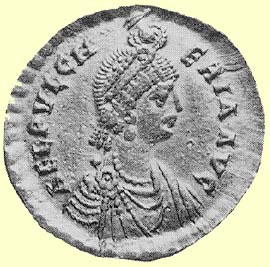 Contents -
Previous Article -
Next Article
Contents -
Previous Article -
Next Article
Aelia Pulcheria was the sister of the Eastern Roman emperor Theodosius II. Theodosius was a weak ruler who did not take much of an active part in the government of the empire, but his sister Pulcheria was quite a gifted administrator. She was the one who held the actual ruling power during the long reign of Theodosius II.
Pulcheria and her brother Theodosius were children of the Eastern Roman emperor Arcadius and his wife Eudoxia. Eudoxia died in A. D. 404 and Arcadius in 408, leaving as orphans the seven year old Theodosius and his three sisters. Though she was only nine years old at the time, Pulcheria was already showing the strong personality and leadership abilities that were a common trait of the Theodosian women.
During Theodosius’ minority, the Eastern Roman Empire was fortunate to have the competent and faithful praetorian prefect Anthemius to act as regent for the young emperor. The education of the imperial children was left in the hands of a powerful group of priests. During their early years, the emperor and his sisters were taught that they held power only in the name of God and that service to the Church was a higher calling than imperial office. This education had such a great influence that the long reign of Theodosius II would be very different from the emphasis on imperial power and magnificence displayed during the reign of Arcadius.
In 414, Theodosius II bestowed the title of Augusta on the fifteen - year old Pulcheria. From that time on, the weak Theodosius was governed by his sister’s powerful personality. At an early age, Pulcheria took a vow of celibacy and assumed somewhat the character of a very powerful and holy nun watching over the government of the empire. This was, in fact, the image she strove to create in the minds of the people and it was largely the support of the church and people that insured that she would remain influential and powerful for decades to come. She also persuaded both of her sisters to take vows of celibacy as a precaution against their marrying a powerful individual who might prove a threat to Theodosius and his sister’s reign. Pulcheria was very powerful in Church politics as well. To a great degree, she was responsible for organizing the Council of Chalcedon in A. D. 451 and setting the agenda of issues to be decided.
In 421 Theodosius married the beautiful Eudocia, who had recently accepted Christianity and had discarded the pagan name of Athenais in favor of a new Christian one. Some historians believe that Pulcheria considered Eudocia a threat to her own power, and gradually turned Theodosius against her. In any case, Theodosius repudiated his wife and exiled her to Jerusalem. The natural consequence to this was that Pulcheria was once again in total control of her brother without anyone interfering with her.
After the death of Theodosius II in A. D. 450, Pulcheria married the strong and capable Marcian, an elderly senator who was known for his competence in governmental and military affairs. Pulcheria was fifty - one years old at the time. This was not a marriage for love, but existed simply to ensure a smooth succession and that the empire would be in good hands. The historians of the period are quite clear that Marcian respected her vow of celibacy and there was none of the affection that normally exists between married couples.
Pulcheria died in A. D. 453, having willed all her possessions to the poor. She is still respected as a saintly woman and an example of one who lived a holy life by the Eastern Orthodox Church.
Go to next article: on Galla Placidia, a Storybook Princess
Go back to previous article: on Eudocia